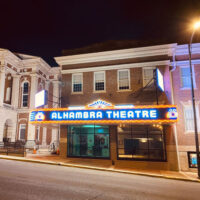The last time the Kentucky New Era made a big move, employees left their old offices at Seventh and Bethel streets and headed for new digs at the edge of town with a big wood-paneled newsroom and typewriters at every reporter’s desk. That was in the spring of 1971.
In several months, the newspaper will return downtown and set up offices on South Main at Eighth Street in the former J.C. Penney building. Staffers will bring different tools – slim laptops, digital cameras and smartphones – because nearly everything in the newspaper business has changed since the New Era last called downtown home nearly 50 years ago.
It turns out those changes mean that a modern newsroom can be a good fit for the heart of town again.

New Era Publisher Brandon Cox likes the idea of getting closer to the action.
“From an editorial perspective, we support what’s going on in downtown Hopkinsville, and we think we should put our money where our mouth is,” he said.
The paper will be directly across the street from city hall, he said, and that is a meaningful nod to journalism’s traditional role as the watchdog of local government.
The move, expected by November, is part of the New Era’s ongoing transition under new ownership.
When Paxton Media, a community newspaper group based in Paducah, bought the New Era and four smaller papers in surrounding communities last fall from the family of then-publisher Taylor Wood Hayes, the press operations ended in Hopkinsville. The New Era is now printed at the company’s regional production hub in Owensboro. Since the acquisition did not include the real estate on East Ninth Street at Skyline Drive, it now makes sense to move to a smaller facility, said Cox.
The newspaper wanted to be downtown, he said, but there was only one available building with a loading dock to handle distribution of the papers when they arrive on trucks around 2:30 a.m. on the New Era’s five publication days.
Hopkinsville businessman Hal McCoy made a deal to buy the former J.C. Penney building and will renovate two vacant bays on the main floor. One bay will be for McCoy, who owns and manages several residential and commercial properties in Hopkinsville. The other bay will house the New Era.
The building is three stories on the front and tapers to two floors at the rear. In addition to the area planned for renovation, the building also has two existing tenants in another bay. Those are Kentucky Legal Aid and American Red Cross.
Cox said the New Era office design includes a reception desk at the front of the building and the newsroom directly behind that. The news staff will have a view of Main Street through the building’s storefront window. In addition, there will be offices for the editor and publisher, a conference room, restrooms and the advertising department. The rear of the building, connected to the loading dock, with have space for handling distribution.
Cox said the New Era’s daily circulation is approximately 7,000, and weekend circulation is slightly higher at 7,200. The New Era has 16 motor delivery routes across Christian County and portions of Todd and Trigg counties.
The delivery drivers, who are contract workers, will pick up their papers at the back of the Main Street building. Other subscribers in Trigg and Todd who don’t live on an established motor route will continue to receive their papers in the mail.
“It’s so important, I think, for the local news to be intimately ingrained and connected to the heart of the community it serves,” he said. “There’s no better way to do that than to be a part of the downtown.”
The New Era employs 10 people in the newsroom, including the sports writers. Zirconia Alleyne, a Hopkinsville native, is the editor.
History Happened Here
The building McCoy purchased this week from Michael Lose (whose company ATS Tactical produced gear there for military special forces) was the second structure on that location, said Christian County historian William T. Turner.
The first building was two stories and brick, and it housed the city’s first photographic studio, beginning in 1858, on the top floor.
Photographer E.L. Foulkes would have taken the images of many Hopkinsville notables on that site. One was Dr. John McCarroll, a physician who accompanied Gen. Andrew Jackson in the Battle of New Orleans, said Turner. The building burned in 1885.
The core of the current building was constructed in 1886, said Turner, and it housed Frankel’s Busy Store with clothing for men, women and children for about four decades.
“The Frankels were a prominent Jewish family in Hopkinsville,” Turner said.
In 1920, the J.H. Anderson department store opened in that location. The Anderson family also had stores in Owensboro and Knoxville. Hopkinsville merchant George Crenshaw later bought the Hopkinsville store and kept the Anderson name.
Around 1942, J.C. Penney became a tenant and ran one of the largest chain stores in the downtown district for nearly 30 years. The store moved out in the early 1970s and went to the new Pennyrile Mall, where it remains in business at Bradford Square.
A New View of Downtown
The decline of downtown Hopkinsville as the town’s commercial hub accelerated in the 1960s and early ’70s with the development of suburban shopping centers such as Indian Hills on Canton Street, Skyline on Fort Campbell Boulevard and Pennyrile Mall.
Recent investments and renewed interest in downtown for historical and cultural value haven’t happened overnight.
McCoy gives a lot of credit to former mayor Dan Kemp and city council for moving the Hopkinsville Municipal Center to the heart of downtown in 2014. Community and Development Services has also pushed revitalization, he said.
“It takes a lot of people and a lot of time to turn it around, and I think we have reached that threshold,” McCoy said.
Last year, McCoy also invested in the former Young Hardware building. It is under renovation to become The Mixer restaurant.
The work at the New Era’s next location will include restoration of the building’s front exterior, he said, along with a complete overhaul of the main floor for his and the newspaper’s separate offices. Later, he’ll consider renovating the upper floors for residential spaces.
Mayor Carter Hendricks sees the New Era’s move as a good sign for downtown.
“We’re very excited,” he said. “It is not just the number of employees they bring. It’s the energy, the prestige, the credibility they bring.”
Back to the Future
If construction goes as a planned, the New Era will move downtown this fall, which will coincide with a celebration of the newspaper’s 150th anniversary.
The oldest known copy of a New Era was printed on Jan. 27, 1871. Turner found the paper, which had been used to make a dress pattern and was torn at the bottom.
That paper, which was a weekly, was labeled as “Vol. 1” and “Edition 28.” If that is correct, the paper might actually have started printing in the summer of 1870. But if the paper skipped publishing some editions, then the first paper could have been published in 1869 as the New Era has always recognized.
Regardless if the paper was established in 1869 or 1870, there is no doubt about the New Era being the oldest business in the community. The second oldest is Hopkinsville Milling, which traces its roots back to 1874.
Hayes’ family became part owners of the Kentucky New Era in 1881 and sole owners in 1900. The Wood family built the paper’s last downtown location, at Seventh and Bethel, in 1910. It still stands.
In fact, it stands so close to the rear of the New Era’s next home, a paper carrier could easily toss a paper from one building to the next.
On leaving downtown in 1971, New Era staff writer Mary D. Ferguson filed a story headlined, “This old house holds many memories that will not be forgotten.”
Ferguson, who wrote for the New Era from 1962 until her death in 2016, described the newspaper being neighbors with a bar, a shoe repairman and a Baptist mission house. From that building, they watched Little River rise and fall, covered thousands of news stories, published obits, weddings and sports scores. Some of those stories occurred steps from the newsroom.
“Believe us when we say, there’s never been a dull moment on Seventh Street,” she wrote.
Later this year, the next generation of New Era journalists will get their chance to experience what Ferguson admired about downtown.
Jennifer P. Brown is co-founder, publisher and editor of Hoptown Chronicle. You can reach her at editor@hoptownchronicle.org. Brown was a reporter and editor at the Kentucky New Era, where she worked for 30 years. She is a co-chair of the national advisory board to the Institute for Rural Journalism and Community Issues, governing board past president for the Kentucky Historical Society, and co-founder of the Kentucky Open Government Coalition. She serves on the Hopkinsville History Foundation's board.





